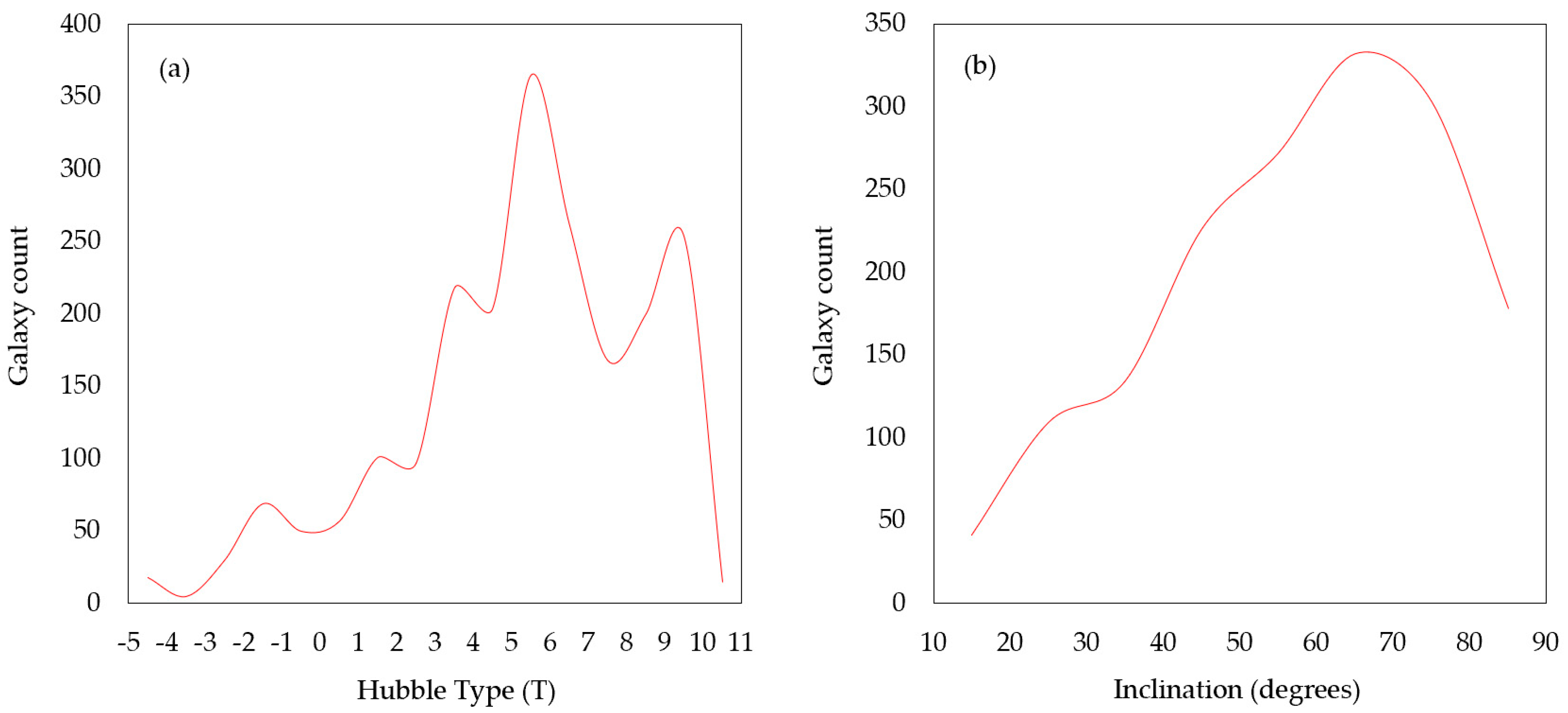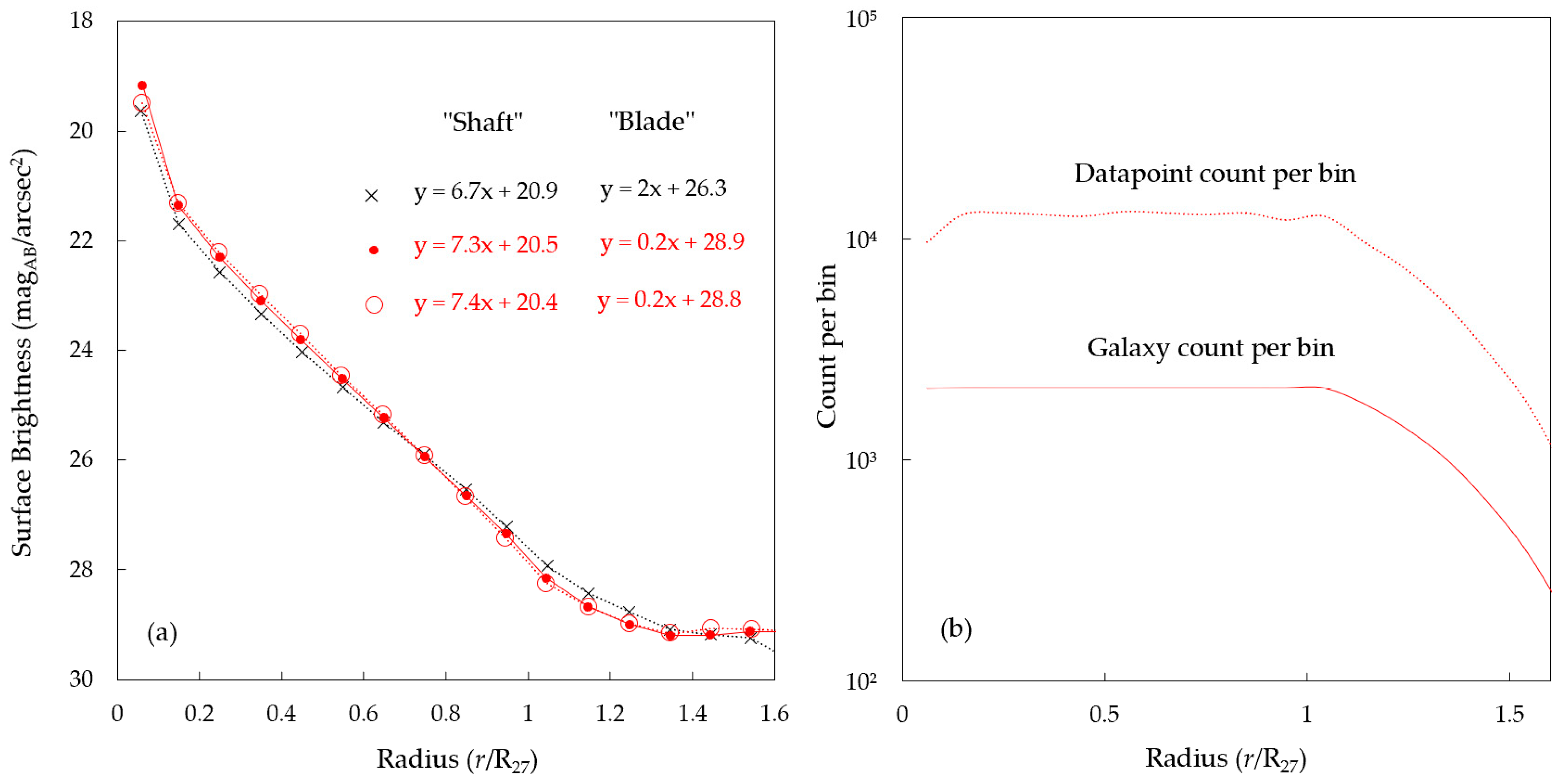Surface Brightness Plateau in S4G Galaxies
Abstract
:1. Introduction
2. Data and Method
3. Results
4. Discussion
Author Contributions
Funding
Conflicts of Interest
References
- Read, J.I.; Gilmore, G. Mass loss from dwarf spheroidal galaxies: The origins of shallow dark matter cores and exponential surface brightness profiles. Mon. Notices R. Astron. Soc. J. 2005, 356, 107–124. [Google Scholar] [CrossRef] [Green Version]
- Kranz, T.; Slyz, A.; Rix, H.W. Dark matter within high surface brightness spiral galaxies. Astrophys. J. 2003, 586, 143–151. [Google Scholar] [CrossRef] [Green Version]
- Kassin, S.A.; de Jong, R.S.; Pogge, R.W. Dark and Baryonic Matter in Bright Spiral Galaxies. I. Near-Infrared and Optical Broadband Surface Photometry of 30 Galaxies. Astrophys. J. Suppl. Ser. 2006, 162, 80–96. [Google Scholar] [CrossRef] [Green Version]
- Dutton, A.A. On the origin of exponential galaxy discs. Mon. Notices R. Astron. Soc. J. 2009, 396, 121–140. [Google Scholar] [CrossRef] [Green Version]
- Tamm, A.; Tenjes, P. Structure of visible and dark matter components in spiral galaxies at redshifts z = 0.5–0.9. Astron. Astrophys. 2005, 433, 31–41. [Google Scholar] [CrossRef]
- Lelli, F.; McGaugh, S.S.; Schombert, J.M. SPARC: Mass models for 175 disk galaxies with Spitzer photometry and accurate rotation curves. Astron. J. 2016, 152, 157. [Google Scholar] [CrossRef] [Green Version]
- Sipols, A.; Pavlovich, A. Dark matter dogma: A study of 214 galaxies. Galaxies 2020, 8, 36. [Google Scholar] [CrossRef]
- Querejeta, M.; Meidt, S.E.; Schinnerer, E.; Cisternas, M.; Muñoz-Mateos, J.C.; Sheth, K.; Knapen, J.; Van de Ven, G.; Norris, M.; Peletier, R.; et al. The Spitzer Survey of Stellar Structure in Galaxies (S4G): Precise stellar mass distributions from automated dust correction at 3.6 μm. Astrophys. J. Suppl. Ser. 2015, 219, 5. [Google Scholar] [CrossRef] [Green Version]
- Salo, H.; Laurikainen, E.; Laine, J.; Comerón, S.; Gadotti, D.; Buta, R.; Sheth, K.; Zaritsky, D.; Ho, L.; Knapen, J.; et al. The Spitzer Survey of Stellar Structure in Galaxies (S4G): Multi-component decomposition strategies and data release. Astrophys. J. Suppl. Ser. 2015, 219, 4. [Google Scholar] [CrossRef] [Green Version]
- Muñoz-Mateos, J.C.; Sheth, K.; Regan, M.; Kim, T.; Laine, J.; Erroz- Ferrer, S.; Gil de Paz, A.; Comeron, S.; Hinz, J.; Laurikainen, E.; et al. The Spitzer Survey of stellar structure in galaxies (S4G): Stellar masses, sizes, and radial profiles for 2352 nearby galaxies. Astrophys. J. Suppl. Ser. 2015, 219, 3. [Google Scholar] [CrossRef] [Green Version]
- Buta, R.J.; Sheth, K.; Athanassoula, E.; Bosma, A.; Knapen, J.H.; Laurikainen, E.; Salo, H.; Elmegreen, D.; Ho, L.C.; Zaritsky, D.; et al. A classical morphological analysis of galaxies in the Spitzer survey of stellar structure in galaxies (S4G). Astrophys. J. Suppl. Ser. 2015, 217, 32. [Google Scholar] [CrossRef] [Green Version]
- Bartko, H.; Martins, F.; Trippe, S.; Fritz, T.K.; Genzel, R.; Ott, T.; Eisenhauer, F.; Gillessen, S.; Paumard, T.; Alexander, T.; et al. An extremely top-heavy IMF in the galactic center stellar disks. Astrophys. J. 2009, 708, 1. [Google Scholar]
- Maness, H.; Martins, F.; Trippe, S.; Genzel, R.; Graham, J.R.; Sheehy, C.; Salaris, M.; Gillessen, S.; Alexander, T.; Paumard, T.; et al. Evidence for a long-standing top-heavy initial mass function in the central parsec of the galaxy. Astrophys. J. 2007, 669, 1024. [Google Scholar] [CrossRef] [Green Version]
- Bland-Hawthorn, J.; Vlajić, M.; Freeman, K.C.; Draine, B.T. NGC 300: An extremely faint, outer stellar disk observed to 10 scale lengths. Astrophys. J. 2005, 629, 239. [Google Scholar] [CrossRef]
- Ferguson, A.M.; Irwin, M.J.; Ibata, R.A.; Lewis, G.F.; Tanvir, N.R. Evidence for stellar substructure in the halo and outer disk of M31. Astron. J. 2002, 124, 1452. [Google Scholar] [CrossRef] [Green Version]
- McConnachie, A.W.; Chapman, S.C.; Ibata, R.A.; Ferguson, A.M.N.; Irwin, M.J.; Lewis, G.F.; Tanvir, N.R.; Martin, N. The stellar halo and outer disk of M33. Astrophys. J. Lett. 2006, 647, L25. [Google Scholar] [CrossRef] [Green Version]
- Martinez-Delgado, D.; Pohlen, M.; Gabany, R.J.; Majewski, S.R.; Penarrubia, J.; Palma, C. Discovery of a giant stellar tidal stream around the disk galaxy NGC 4013. Astrophys. J. 2009, 692, 955. [Google Scholar] [CrossRef]
| 1 | R27 is a galactocentric radius at which 3.6 μm surface brightness, as detected by Spitzer IRAC channel 1, first reaches or crosses the level of 27 magAB/arcsec2. |
| 2 | |
| 3 | |
| 4 | |
| 5 |




© 2020 by the authors. Licensee MDPI, Basel, Switzerland. This article is an open access article distributed under the terms and conditions of the Creative Commons Attribution (CC BY) license (http://creativecommons.org/licenses/by/4.0/).
Share and Cite
Sipols, A.; Pavlovich, A. Surface Brightness Plateau in S4G Galaxies. Galaxies 2020, 8, 48. https://doi.org/10.3390/galaxies8020048
Sipols A, Pavlovich A. Surface Brightness Plateau in S4G Galaxies. Galaxies. 2020; 8(2):48. https://doi.org/10.3390/galaxies8020048
Chicago/Turabian StyleSipols, Alan, and Alex Pavlovich. 2020. "Surface Brightness Plateau in S4G Galaxies" Galaxies 8, no. 2: 48. https://doi.org/10.3390/galaxies8020048
APA StyleSipols, A., & Pavlovich, A. (2020). Surface Brightness Plateau in S4G Galaxies. Galaxies, 8(2), 48. https://doi.org/10.3390/galaxies8020048




